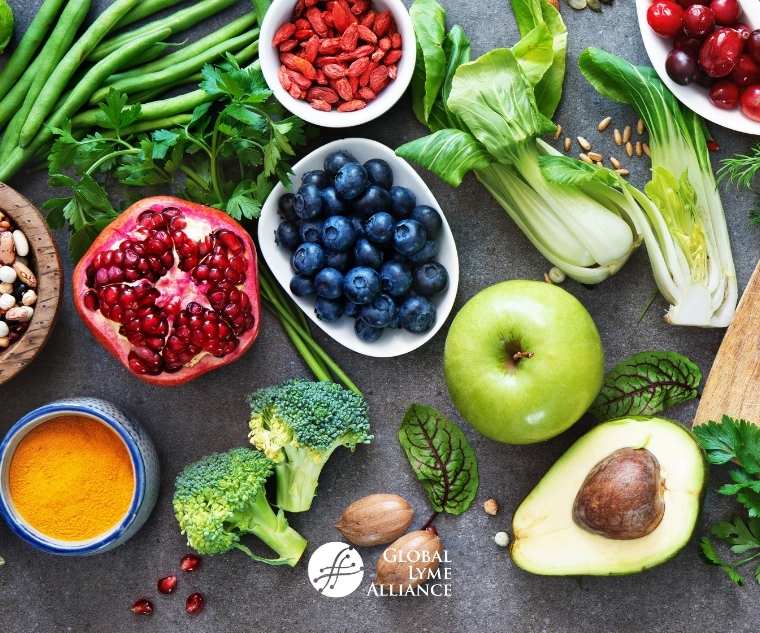
Lindsay Christensen, MS, CNS, LDN, CKNS is a Clinical Nutritionist at Ascent to Health and ADAPT Certified Functional Health Coach. She's giving advice to Lyme patients on the best food practices that promote healing and wellness.
Lyme disease is one of the fastest-growing vector-borne infectious diseases in the United States. Contracted from the bite of a black-legged tick carrying Borrelia bacteria, at least 476,000 people are newly diagnosed each year in the U.S., and as of 2020, as many as 2 million people may have chronic Lyme disease. (1)
As a clinical nutritionist who works in private practice primarily with clients who have Lyme disease, I’ve seen firsthand how simple dietary changes can support healthy immune function, boost energy, improve cognitive function, and alleviate chronic pain in individuals with Lyme disease. While nutrition cannot cure Lyme disease, it can significantly ease symptoms and improve your overall health, complementing pharmaceutical and herbal Lyme treatment protocols and accelerating the healing process. Yet, unfortunately, nutrition is often placed on the back burner and sometimes wholly overlooked in Lyme disease treatment protocols.
In my opinion, nutrition shouldn't be relegated to the back burner but should be placed front and center in the Lyme disease treatment process. When your nutrition is optimized during Lyme treatment, it can help you feel better faster and even support greater resilience on one's health. Read on to learn about why optimizing your nutrition should be a top priority if you desire long-term recovery from Lyme disease and why eating an anti-inflammatory diet is the best place to begin improving your diet.
Step 1: Eat an Anti-Inflammatory Diet to Accelerate Lyme Healing
Borrelia burgdorferi, other Borrelia species involved in Lyme, and Lyme co-infections induce a profound inflammatory response in the body that affects a wide variety of tissues and organs, ranging from the brain to the skin to the joints. (2, 3) This inflammatory response is an attempt by the immune system to clear infections, but it can go haywire and create excessive inflammation in Lyme disease. Interestingly, a rapidly growing body of scientific research indicates that nutrition profoundly affects the inflammatory status of the human body; in other words, the foods we eat can either exacerbate or inhibit inflammation. Since numerous Lyme disease symptoms stem from an out-of-control inflammatory response, reducing your baseline level of inflammation by eating well can significantly improve your symptoms and even allow your immune system to function in a more balanced, productive way!
 The first step in improving your nutrition to support Lyme recovery is to remove inflammatory foods from your diet. There are three main food groups that individuals with Lyme disease should avoid:
The first step in improving your nutrition to support Lyme recovery is to remove inflammatory foods from your diet. There are three main food groups that individuals with Lyme disease should avoid:
- Processed foods
- Refined carbohydrates and sugar
- Industrial seed oils
The standard American diet is heavy in processed foods, refined carbohydrates, and industrial seed oils. Consuming these foods increases chronic inflammation and does no favors for the already inflamed Lyme disease patient. (4)
Refined carbohydrates and added sugars, such as cane sugar and high-fructose corn syrup, reduce the efficacy of white blood cells, which are key cells in the immune system, and promote the growth of inflammatory gut bacteria. (5, 6) Between 70 and 80 percent of your immune system resides in your gut, so when your gut microbiota is imbalanced and contributing to inflammation, your immune function and thus your ability to overcome Lyme disease will suffer. Removing refined carbohydrates and added sugars from your diet is essential for reducing inflammation in Lyme disease. (7, 8)
Industrial seed oils are the oils expressed from oilseeds, including canola (rapeseed), corn, cottonseed, grapeseed, safflower, soybean, and sunflower oils. These oils are very recent additions to the human diet and, research suggests, increase inflammation upon consumption. Industrial seed oils are high in omega-6 fatty acids and oxidized byproducts created during the oil manufacturing process, both of which trigger inflammation when consumed in excess. (9) To reduce inflammation, it is crucial that you avoid industrial seed oils such as soybean, corn, and canola oils and replace them with healthy fats like olive oil and avocado oil.
Gluten and Dairy Often Promote Inflammation in Lyme Disease
I find that many of my clients with Lyme disease do best avoiding gluten and dairy products since both of these foods can instigate inflammation. Gluten, for example, is known to punch holes between the cells that line the intestine, allowing gaps to form. Substances subsequently leak between these gaps from the inside of the gut into the bloodstream, triggering an inflammatory response. (10) This phenomenon is referred to as “leaky gut.” When the immune system identifies substances in the bloodstream derived from leaky gut it “tags” them as foreign and launches an attack. This attack precipitates chronic inflammation that can manifest as skin irritations, brain fog, depression, anxiety, and even joint pain. In people with Lyme disease, removing gluten can stem the tide of leaky gut and reduce overall inflammation levels.
Many gluten-sensitive people are also sensitive to dairy proteins because gluten proteins and proteins in dairy share structural similarities. This means that if the immune system is already bent on "attacking" gluten, it may do the same with dairy proteins, creating more inflammation. There are two primary ways to determine if you're sensitive to gluten and dairy if you have Lyme disease. One way is to do a 60-day trial of a gluten-free, dairy-free diet and track shifts in symptoms along the way. The other way is to do gluten and dairy sensitivity testing through a qualified nutritionist to identify whether you're experiencing an immune response to gluten and dairy.
Create Your Anti-Inflammatory Dietary Template
Once you’ve removed inflammatory foods from your diet, it’s time to build your anti-inflammatory eating plan!Incorporate the following foods into your diet to keep inflammation at bay:
Grass-fed and organic animal proteins: I have found in clinical practice that most of my clients with Lyme disease do best on an omnivorous diet that includes animal proteins such as beef, poultry, fish, and eggs. Animal proteins contain all nine essential amino acids required by the body and are crucial for repairing tissues and synthesizing neurotransmitters that regulate mood and sleep. Animal proteins also contain micronutrients necessary for a healthy immune system and brain function, including zinc, copper, iron, and vitamin B12. I encourage clients to choose animal proteins from grass-fed and organic sources to avoid exposure to synthetic hormones and pesticide residues in industrially-raised meat, poultry, eggs, and fish.
 Fatty cold-water fish: Fatty cold-water fish are rich in the omega-3 fatty acids EPA and DHA, which play crucial roles in regulating inflammation in the body. Many people don’t get enough omega-3 fatty acids in their diets; this is particularly problematic for those with Lyme disease because omega-3 fatty acids can help dampen Lyme-associated inflammation. (11) Use the SMASH acronym to remember which types of seafood are highest in omega-3 and lowest in mercury. SMASH stands for "salmon, mackerel, anchovies, sardines, and herring." Aiming for at least three servings per week is ideal.
Fatty cold-water fish: Fatty cold-water fish are rich in the omega-3 fatty acids EPA and DHA, which play crucial roles in regulating inflammation in the body. Many people don’t get enough omega-3 fatty acids in their diets; this is particularly problematic for those with Lyme disease because omega-3 fatty acids can help dampen Lyme-associated inflammation. (11) Use the SMASH acronym to remember which types of seafood are highest in omega-3 and lowest in mercury. SMASH stands for "salmon, mackerel, anchovies, sardines, and herring." Aiming for at least three servings per week is ideal.
At least three to four servings of non-starchy vegetables per day: Non-starchy vegetables provide dietary fiber, vitamin C, B vitamins, and phytochemicals with anti-inflammatory and gut health-supporting properties. Examples of non-starchy veggies include leafy greens like kale, spinach, and collard greens, mushrooms, bell peppers, zucchini, and onions.
 Eat nutrient-dense carbs. Starchy tubers, root vegetables, and whole fruits are optimal sources of carbohydrates for people with Lyme disease because they promote a balanced blood sugar response and are rich in vitamins, minerals, and antioxidants with anti-inflammatory activities. Blood sugar levels significantly impact inflammation levels, so choosing carbs that support healthy blood sugar control is crucial for recovery.
Eat nutrient-dense carbs. Starchy tubers, root vegetables, and whole fruits are optimal sources of carbohydrates for people with Lyme disease because they promote a balanced blood sugar response and are rich in vitamins, minerals, and antioxidants with anti-inflammatory activities. Blood sugar levels significantly impact inflammation levels, so choosing carbs that support healthy blood sugar control is crucial for recovery.
Choose healthy fats. Avoid industrial seed oils and instead focus on healthy, anti-inflammatory fats such as extra virgin olive oil, coconut oil, avocado oil, avocados, and nuts and seeds.
In my experience, gluten-free grains, such as oats and rice, and legumes, like lentils and soy, are a gray area for many people with Lyme disease. These foods are dense carbohydrate sources and can spike blood sugar for many people; frequent blood sugar spikes are known to cause inflammation. (12) Grains and legumes also contain antinutrients, which are compounds that protect the grain and legume plants against pests and disease but interfere with our bodies' abilities to absorb nutrients from food. For example, phytic acid is an antinutrient present in the bran and outer hull of grains that impairs our ability to absorb various minerals, including zinc and iron, stimulates the immune system, and can promote leaky gut. For these reasons, I suggest minimizing your intake of gluten-free grains and legumes to a few servings a week and instead focusing more on anti-inflammatory, nutrient-dense starchy tubers, root vegetables, winter squashes, and whole fruits for carbs and fiber. Keep in mind that some people with Lyme disease who have gut issues, autoimmunity, or blood sugar dysregulation may do best on a grain-free and/or legume-free diet.
You may also want to incorporate specific functional foods with anti-inflammatory properties into your diet, such as:
Cruciferous vegetables: Cruciferous vegetables, such as broccoli and cauliflower, contain phytonutrients called glucosinolates that increase glutathione production. (12) Glutathione is an antioxidant and immune-signaling molecule that plays a crucial role in the immune response to Borrelia. (13, 14) Eating various cruciferous vegetables, including some that are raw or just lightly cooked to preserve the glucosinolate content, can help your body generate glutathione for your immune defenses.
 Blueberries: Borrelia spirochetes stimulate macrophages, including glial cells in the brain, to release the inflammatory cytokines IL-6 and TNF-α. Excessive production of these molecules has neurotoxic effects on the brain. In animal studies, blueberries have been found to reduce IL-6 and TNF-α production and may thus help protect the brain and dampen overall inflammation. (15)
Blueberries: Borrelia spirochetes stimulate macrophages, including glial cells in the brain, to release the inflammatory cytokines IL-6 and TNF-α. Excessive production of these molecules has neurotoxic effects on the brain. In animal studies, blueberries have been found to reduce IL-6 and TNF-α production and may thus help protect the brain and dampen overall inflammation. (15)
Extra virgin olive oil: Oleuropein, a significant component of extra virgin olive oil, also reduces the production of the inflammatory cytokines IL-6 and TNF-α involved in the Lyme-induced inflammatory response. Be sure to choose organic olive oil to avoid consuming pesticide or herbicide residues, which have immune system-disrupting effects, in your olive oil.
Eating an anti-inflammatory diet can help significantly with Lyme disease recovery. Nutrition shouldn’t be pushed to the back burner but rather should be a central component of any comprehensive treatment approach to Lyme disease.
Stay tuned for part 2 of this blog series, in which I’ll discuss how to use nutrition to support optimal immune function.
***
To read more of our blogs, click here.

Lindsay Christensen
GLA Contributor
Opinions Expressed by contributors are their own. Lindsay Christensen, MS, CNS, LDN, CKNS is a Clinical Nutritionist at Ascent to Health and ADAPT Certified Functional Health Coach. If you have Lyme disease and need one-on-one nutrition support, consider working with me in my clinical nutrition practice, Ascent to Health. In my practice, I help clients with Lyme disease restore their energy, mental clarity, and gut health so that they can feel their best and be fully engaged in their lives. In addition, I help my clients uncover the factors standing in the way of a full recovery and optimize their health from the ground up, using science-based functional nutrition and lifestyle strategies.
Email: lindsay@ascent2health.com
Website: https://www.ascent2health.com/






-2.jpg)